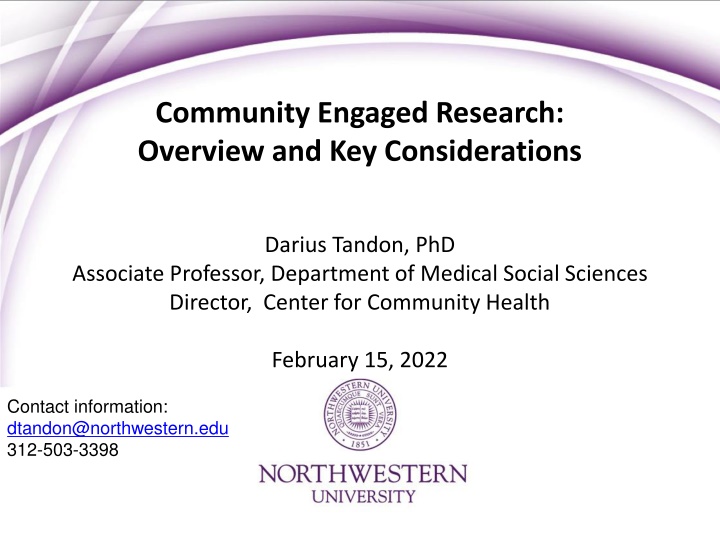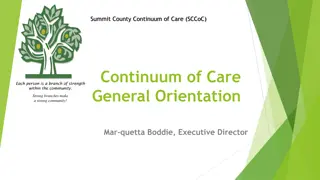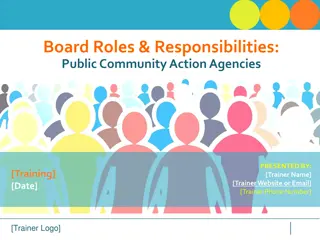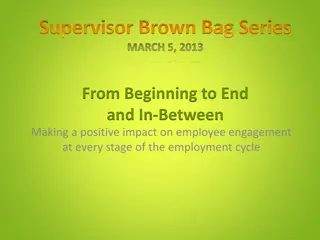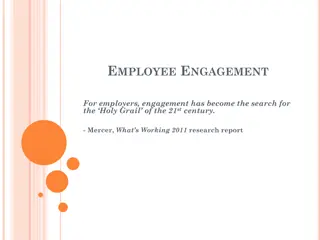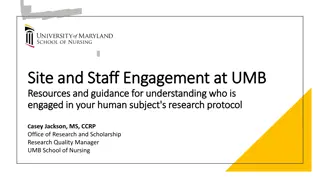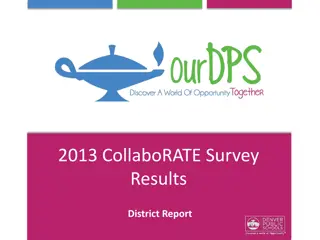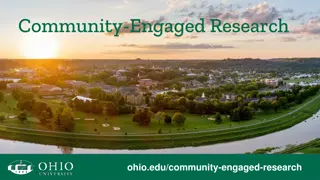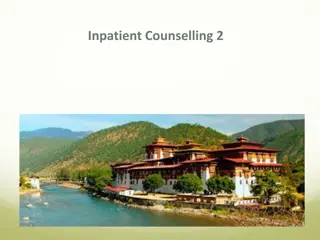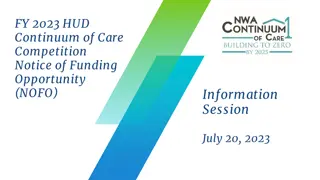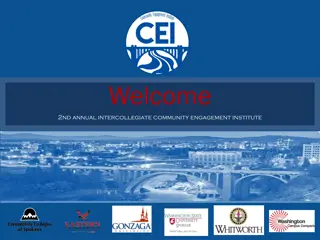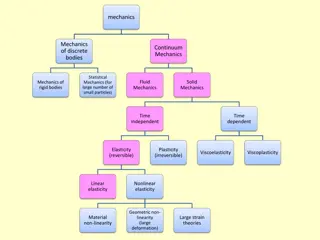Community-Engaged Research: Key Considerations and Engagement Continuum
This overview delves into community-engaged research led by Darius Tandon at Northwestern's Center for Community Health. It defines community engagement, highlights the importance of collaboration across various levels, and explores the spectrum of engagement from feedback to active partnership. The stakeholder engagement continuum is also discussed, emphasizing the stages of informing, consulting, involving, collaborating, and empowering stakeholders in decision-making processes.
Download Presentation

Please find below an Image/Link to download the presentation.
The content on the website is provided AS IS for your information and personal use only. It may not be sold, licensed, or shared on other websites without obtaining consent from the author.If you encounter any issues during the download, it is possible that the publisher has removed the file from their server.
You are allowed to download the files provided on this website for personal or commercial use, subject to the condition that they are used lawfully. All files are the property of their respective owners.
The content on the website is provided AS IS for your information and personal use only. It may not be sold, licensed, or shared on other websites without obtaining consent from the author.
E N D
Presentation Transcript
Community Engaged Research: Overview and Key Considerations Darius Tandon, PhD Associate Professor, Department of Medical Social Sciences Director, Center for Community Health February 15, 2022 Contact information: dtandon@northwestern.edu 312-503-3398
Northwestern Center for Community Health (CCH) Mission: To catalyze, support, and conduct meaningful community and academic engagement across the research spectrum to improve health and health equity. Programs: Alliance for Research in Chicagoland Communities (ARCC) Northwestern Primary Care Research Program (NP3) Consultations Dissemination & Implementation 2
Community Engagement Definition Collaboration between institutions of higher education and their larger communities (local, regional/state, national, globe) for the mutually beneficial exchange of knowledge and resources in a context of partnership and reciprocity. --Carnegie Foundation for the Advancement of Teaching (2015) 3
Community Engagement Definition (cont) An orientation to research Fundamentally changes a researcher s role Not a research method or research design Community engagement can use a diversity of methods or research designs Strong connection to patient-centered outcomes research (PCOR) PCOR s focus on studying questions and outcomes that are meaningful to patients is well-supported by a community- engaged approach 4
The Engagement Continuum Spectrum of engagement ranging from simply giving feedback to stakeholders (i.e., least engaged) to active, ongoing collaboration with researchers and other stakeholders as equal partners throughout research trajectory (i.e., most engaged)
Stakeholder Engagement Continuum Inform Consult Involve Collaborate Empower We will consider your input and give feedback about how it informed our decisions We will work together to decide and ensure everyone s views are incorporated as much as possible We will ensure that your input is considered among the choices we implement We will implement what you decide We will keep you informed Source: International Association for Public Participation, 2007
Why Involve Community Stakeholders in Research? Increasing calls for patient & stakeholder engagement in research PCORI, NIH, FDA Growing evidence patients and stakeholders provide value in developing and implementing research Many other perspectives beyond researchers that can help develop/implement projects 7
Who are Community Stakeholders ? Stakeholder: An individual or group who is responsible for or affected by health- and healthcare-related decisions that can be informed by research evidence (Concannon et al., 2012)
Who are Stakeholders? Patients: current and potential consumers/users of patient-centered healthcare Providers: Individuals & organizations providing care to patients Purchasers: individuals underwriting costs of healthcare (e.g., employers) Payers: those responsible for reimbursement of healthcare Policy makers: those responsible for shaping policy (including policy advocates) Product makers: Drug & device manufacturers Principal investigators & other researchers Concannon et al. (2012). A new taxonomy for stakeholder engagement in patient-centered outcomes research. J Gen Intern Med 27(8):985-91
Selecting Stakeholders Not all stakeholder categories will be relevant for a given project (e.g., drug/device manufacturers) Considerations in selecting: Funder requirements (e.g., PCORI, NIH) Objectives of project Type of input needed Importance of obtaining broad spectrum of perspectives What type of input is needed pre-award, during project, and post-award
Selecting Stakeholders Stakeholder input can be valuable regardless of: Type of project (T0-T4) (Kost et al., 2016) Ex.) T0-T1 study identifying genetic basis for undue susceptibility to specific infections in a population with a known congenital syndrome Investigator engaged with clinicians, parents, & national advocacy groups that work with population to better understand population s concerns Current phase of project Pre-award Study execution Post-award (sustainability, dissemination, future grant submissions) 11
Finding and Selecting Community Stakeholders Build on Existing Relationships Referrals/recommendations from colleagues Centers or Institutes at NU (like the Center for Community Health) who work with different stakeholders Need to be mindful of not only recruiting/working with the usual suspects 12
What Can Maximize Likelihood That Stakeholders Will Collaborate? Clearly defining roles and responsibilities of stakeholders Clearly articulating what they will gain/being responsive to why stakeholders would want to participate Promoting access to new treatments or therapies (patients) Determining more sustainable models for implementing healthcare (providers) Developing sound bites/materials that can be used to recruit Linked to project goals, roles/responsibilities, and what members will gain
When During a Research Project Can Stakeholders be Engaged? Project development/Shaping purpose & scope Project implementation Interpretation and Application of Research Outcomes Cargo & Mercer (2008). The values & challenges of participatory research: Strengthening its Practice, Annual Review of Public Health
Project development/ Shaping purpose & scope 15
Types of Engagement During Project Development 1. Getting to know each other/building relationships -- Is this a new partnership? -- PCORI Pipeline to Proposal , ARCC Seed Grant awards for partnership development 2. Input on additional patients/stakeholders to involve -- How to expand beyond involving one type of stakeholder? (Critical for PCORI & NIH funding)
Types of Engagement During Project Development 3. Enhancing understanding of health issues -- Via focus groups, survey, town hall, informal discussions, etc. -- Is the health topic relevant to stakeholders and what are the research questions of most importance? --Distinction between research participant providing community stakeholder insight and research collaborator working with academic team
Types of Engagement During Project Development 4. Selecting key comparators (for comparative effectiveness studies) --Some key considerations: a) Risk/benefit b) Cost c) Stigma d) Ability to access intervention/service/program 18
Types of Engagement During Project Development 5. Ensuring patient-centeredness of study outcomes -- Are outcomes meaningful for study participants? 6. Providing letters of support -- Letters by themselves do not represent strong patient & stakeholder engagement
Types of Engagement During Project 1. Development of recruitment and retention strategies Where should recruitment take place? What are incentives that will keep participants engaged? What are appropriate (and inappropriate) terms/phrases for recruitment flyers and consent forms? Are there community or clinical (e.g., health clinics) organizations that can destigmatize study participation? Can community members be hired to help with recruitment and retention?
Types of Engagement During Project 2. Development of contextually/culturally relevant intervention strategies Selecting time & location for intervention What experience does community/clinic have with other interventions? Identifying skills/experiences needed for intervention staff; hiring community stakeholders to fill these roles
Types of Engagement During Project 3. Translating efficacious interventions into new and/or community/clinical settings Variability in culture, resources, organizational capacity, etc. How to maximize strengths/resources of community/clinical setting? Existing staff that can provide intervention/services/assessment Utilizing data systems
Types of Engagement During Project 4. Improvement of measurement tools and process for data collection Selection of appropriate instruments and/or creation of appropriate questions if existing instruments do not exist Hiring and training community stakeholders to assist with data collection (to alleviate cultural/language barriers & apprehension about joining research study)
Interpretation and Application of Research Outcomes 25
Interpretation and Application of Research Outcomes Assisting in interpretation of research findings Are researcher interpretations of the data the same as stakeholder interpretations? Are some findings difficult to understand/interpret?
Interpretation and Application of Research Outcomes Assisting in developing dissemination plans NIH, PCORI, and many other funders require dissemination plans How to increase usefulness of research findings beyond sharing with scientific community? Who should hear about the findings and how? How should data be presented to studyparticipants in a way that results are understood? How should data be presented to other stakeholders (e.g., practitioners, community groups) in a way that results can be used?
Interpretation and Application of Research Outcomes Assisting in sustaining programs beyond initial grant period Through community stakeholders networks, integration of programs with existing programs/structures can be facilitated Local ownership of intervention/program likely to be greater because of ongoing collaboration Certain stakeholders e.g., policy-makers, payors, healthcare administrators can facilitate sustainability
Resources Community Engaged Research resources: http://arccresources.net Community, Patient, & Clinician Engagement in Research Key Considerations and FAQ: http://www.feinberg.northwestern.edu/sites/cch/do cs/Engagement_FAQ2_21_14.pdf PCORI Patient Engagement Rubric: http://www.pcori.org/sites/default/files/Engagemen t-Rubric.pdf 29
